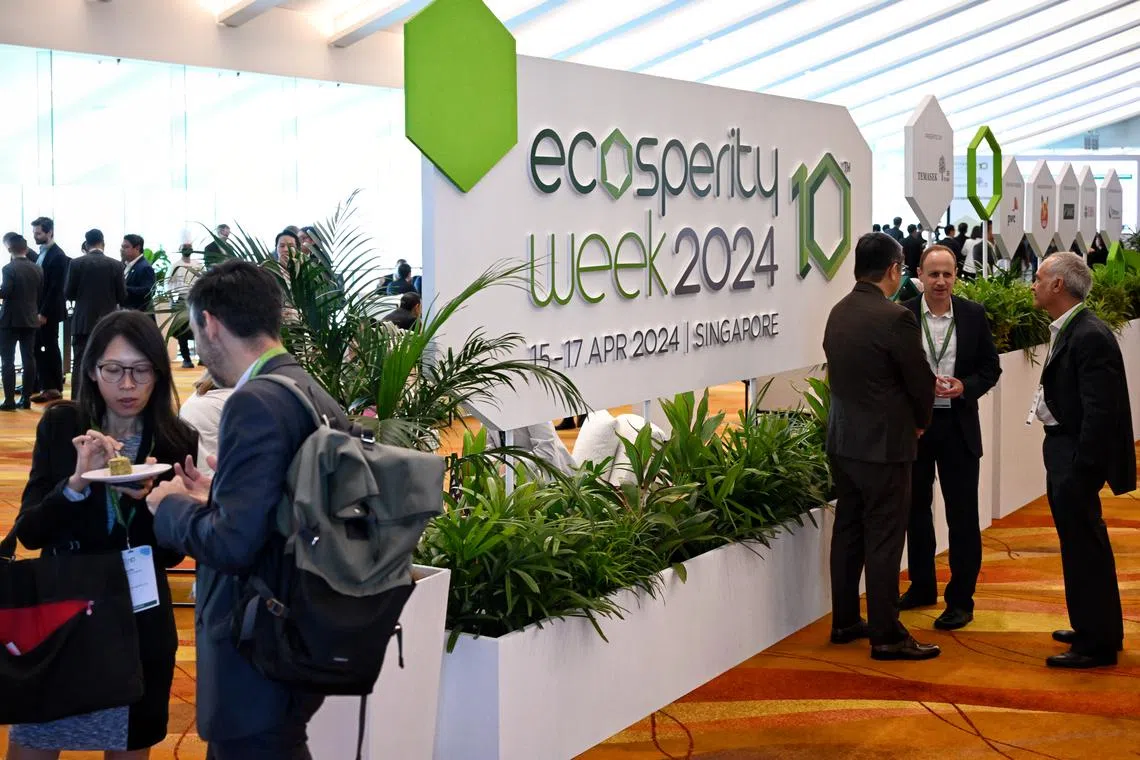Want to save the world and fight climate change? Saving nature is the key, experts say
Sign up now: Get ST's newsletters delivered to your inbox

The world’s coral reefs are in the throes of a global bleaching event caused by record ocean temperatures.
PHOTO: AFP
Follow topic:
SINGAPORE - The world cannot solve the climate crisis without also investing in the protection and restoration of nature, and doing so will unlock huge opportunities for businesses and societies.
This was the key message on April 16 during Ecosperity Week 2024, a sustainability conference convened by Singaporean investment company Temasek and held from April 15 to 17 at Sands Expo and Convention Centre.
“We cannot meet the goals of the Paris (climate) agreement without nature. Investing in nature-based solutions is a key opportunity, and it is projected to create over 390 million jobs by 2030, as well as unlock US$10.1 trillion (S$13.8 trillion) in business opportunities,” said Ms Razan Al Mubarak, president of the International Union for Conservation of Nature, the world’s largest conservation network.
But for that to happen, annual investments in nature need to triple to more than US$500 billion annually, she said.
A key problem is getting businesses to fully take into account the true value of natural assets, or natural capital, and be willing to invest in their protection, the conference heard.
Businesses and the global economy are dependent on the materials nature provides and its many services, such as providing clean air and water.
Products from noodles to shampoos require ingredients from nature. “Quite a lot of different companies and their supply chains actually depend on nature,” said Mr Frederick Teo, chief executive of GenZero, a Temasek-owned investment platform.
And yet, very few companies have truly assessed both the value of nature to their businesses, and their own impact on it.
“Only 5 per cent of companies have mapped their impact on nature. Less than 1 per cent have actually thought about the dependencies their business model has on nature,” said Mr Peter Bakker, president of the World Business Council for Sustainable Development.
But there is hope, and new types of financing can help make the case for investing in nature. The key is making the climate connection.
“One way of actually addressing the worst impacts of climate change, one of the cheapest and faster ways of doing this, is actually investing in nature,” Mr Teo told The Straits Times.
“For us, the way we are thinking about making it work is that we derive alternative revenue streams from our nature investments, which includes revenues from carbon credit sales,” he said, pointing to money generated from projects that remove CO2 from the air or avoid CO2 or other greenhouse gases, such as methane, being emitted – for instance, investing in more efficient rice cultivation, or reforestation or afforestation.
Other revenue streams could be timber from sustainable forestry, and products from sustainable agriculture. “These (revenue streams) are quite useful because people now want to also provide a little bit of risk mitigation just in case something goes wrong with the carbon markets, or carbon prices decline dramatically,” he said.
Speakers during panel discussions lamented the accelerating loss and destruction of nature, and how this will only threaten human livelihoods and economies.
It will also worsen the climate crisis because ecosystems including rainforests, mangroves, seagrass meadows, grasslands and soils soak up large amounts of planet-warming CO2 from the air, playing a key role in regulating the potent greenhouse gas in the atmosphere.

The Ecosperity Week 2024 is a sustainability conference convened by Singaporean investment company Temasek.
PHOTO: KUA CHEE SIONG
Damaging and destroying these key natural systems, for example by clearing for agriculture, mining and urban development, leads to more CO2 in the air and species loss, and affects the local climate.
Overshadowing the conference was confirmation from the US’ National Oceanic and Atmospheric Administration that the world’s coral reefs are in the throes of a global bleaching event caused by record ocean temperatures.
Reefs are vital for fisheries and livelihoods for hundreds of millions of people. Their economic value has been estimated at US$2.7 trillion annually.
“When global warming happens, you will have more species loss, and when you have more species loss, that will also result in more global warming,” said Mr Sunny Verghese, CEO of Olam International. “So these existential challenges of climate change, collapse of biodiversity, livelihoods and growing inequity are interlinked, and we need to address this as a whole system.”
For Olam, as an agri-business supplying food and other materials, the health of the natural world is critical to the firm’s bottom line – especially pollinators, he said.
According to the World Economic Forum, about 75 per cent of crops depend on pollinators such as bees, birds and beetles. Yet recent declines in bees from pollution, land clearance and climate change have cost food producers, including Olam, millions of dollars in lost revenue.
Professor Partha Dasgupta, a leading thinker on the economics of biodiversity, told the conference that nature is a one-stop shop for products and services for humanity. Climate regulation is only one part of the services it provides.
“We should not talk about climate and nature separately,” he said. Nature provides goods that everyone needs, such as food, water, timber and ingredients to make pharmaceuticals – “the stuff we harvest and mine”, said Prof Dasgupta, the Frank Ramsey Professor Emeritus of Economics at the University of Cambridge.
But crucially, nature also provides services that are far less visible but essential. In addition to pollination, this includes nitrogen fixation, production of oxygen, water cleansing by wetlands and decomposition of waste.
And all of these natural services are interconnected, he said.
So how to speed up nature-based investments? Currently, a lot of nature investments rely on concessionary capital from government grants and philanthropic funding. But this is not enough. Debt financing at scale could really get nature investments moving, said Mr Teo, because it has a lower cost of capital than equity financing.
“Debt financing is a way to unlock resources towards supporting nature,” he said. Crowding in debt financing with concessionary capital and philanthropic funds will lower the costs and spread the risks of investments.
But the speakers, as in all climate and biodiversity conferences these days, noted that time was very short to pull the planet back from the brink of catastrophic impacts from climate change and loss of nature, such as faster melting of ice caps or loss of the Amazon rainforest.
British polar explorer Robert Swan, 67, had a final message for the conference: “I believe the last great exploration left on Earth is for us as a species to survive on Earth. And the future heroines and heroes of that journey – you’re it. So I wish you luck on that journey.”


